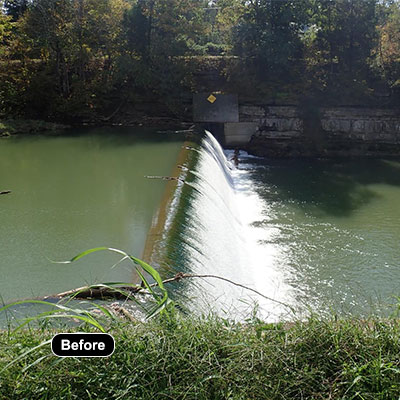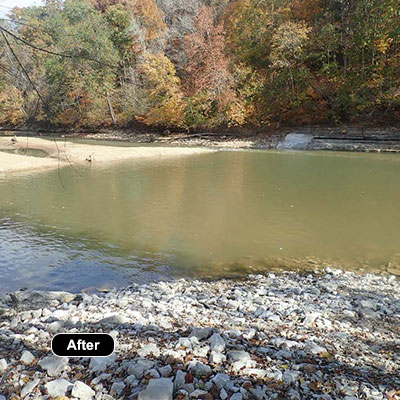Select image to enlarge and view caption.
Interior Plateau Region
What makes this region unique
The unique characteristics of the Interior Plateau region shape the fish and wildlife that inhabit it. When you’re in this region, you’re within the most forested and rugged part of the state, which maintains its steep terrain because glaciers did not scrape the area flat. You’ll observe noticeable transitions between plants from a slope’s north side to its south side. Though timber rattlesnakes call the dry, rocky ridgetops of the hills home, living among the oaks and hickories, you’ll rarely detect their presence. In the oldest sugar maple trees, you could find the Cerulean warbler making its nest or picking away at insects for its young.
In the shallowest soils, grass-dominated communities coexist with gnarled blackjack oak trees, while in the rockiest places, sparse vegetation grows next to exposed rock faces. The Interior Plateau Region contains the most extensive network of below-ground caves and sinkholes with distinct invertebrates and animals adapted to life in complete darkness. In the winter, you may be walking atop this cave network without even knowing that, below you, Indiana bats have returned home to hibernate in the caves.
If you are enjoying a float on the clean and clear water of the Blue River, you might be sharing the river with a hellbender, a river-dwelling salamander. If you’re in the area, you might notice the state’s recovery efforts to increase the hellbender population through reintroduction and river restoration projects, which help to clean the water as it enters the hellbender’s Blue River home.
The region is also unique in that it is home to fish and wildlife that thrive in its remaining wild places.
State wildlife action planning in the Interior Plateau region
In February 2024, partners from the Interior Plateau convened to discuss the ecosystems and species that are in need of conservation in the region. Then, conservation strategies were built around the most pressing threats to these ecosystems. Additionally, in 2024, we’ll be working with partners to further refine elements of the regional plan. Partners who have not been involved in the work are welcome to participate in the refinement process.
Curious about who has been involved in the process? Check out our list of partners below.
- Thank you, partners!
- American Bird Conservancy
- Bartholomew County SWCD
- Big Oaks National Wildlife Refuge
- Hoosier Environmental Council
- Hoosiers for Fishable Streams
- Indiana Association of Soil and Water Conservation Districts
- Indiana Department of Environmental Management
- Indiana Forest Alliance
- Indiana Sentinel Landscape
- Indiana University Bloomington
- Indiana University Columbus
- International Crane Foundation
- Lewis and Associates Biological Consulting LLC
- Natural Resources Conservation Service
- Oxbow Inc.
- Pheasants Forever / Quail Forever
- Purdue University
- Sam Shine Foundation
- State of Indiana Cooperative Invasive Species Management
- Sycamore Land Trust
- The Nature Conservancy
- U.S. Fish and Wildlife Service
- U.S. Forest Service
Interested in learning more about the progress of the Interior Plateau regional plan? Contact Elizabeth Mabee (SWAP@dnr.IN.gov; 463-203-3095).
Conservation at work
- Big Indian Creek Dam Removal Creates Possibility for Hellbender Reintroduction
In Corydon, Indiana DNR has partnered with the U.S. Fish and Wildlife Service and the Nature Conservancy to remove three dams. Doug Nusbaum, a restoration biologist, is currently in the process of helping remove the final dam from Corydon’s Big Indian Creek. The creek shares similar habitat characteristics with the Blue River, which houses hellbenders. Because of these similarities and the creek’s possible hydraulic connection to the Blue River, Nusbaum hopes that Division of Fish & Wildlife can work to reintroduce hellbenders into Big Indian Creek.
Not only can hellbenders possibly be reintroduced with the dam removed, but fish also now have free range to travel back and forth between areas, along with other migrating organisms. Nusbaum is proud to complete these restoration jobs because they support the safety of river users as well as aquatic species. "[Dam removals] benefit wildlife, but the users also benefit from the work we do, too,” he says.
Learn more about the Lake and River Enhancement (LARE) program.


Additional Resources
- Want to learn more about other fish and wildlife that live in Indiana?
- Read about this region in the Indiana State Wildlife Action Plan.
